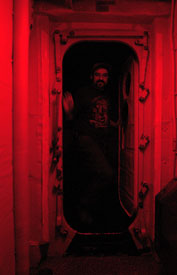 |
Daily Update
Calendar
Dispatch 38 - October 17, 2003
By C. A. Linder
Weather conditions: Overcast skies, intermittent snow, 25
kt winds, 5-7 ft seas, air temperature 32°F
Nome-ward Bound
Following winds and seas pushed us onward today, southward through the Chukchi Sea. The stable weather conditions have allowed us to make excellent time, and with luck we will all be disembarking in the small town of Nome, Alaska tomorrow.
While the rest of us were packing
and cleaning, Christina Courcier worked
like mad to finish analyzing all of the salt samples. She uses a
machine called a salinometer to determine how much salt is in the
water. I asked her to describe what it's like working in the "salt
mines!"
"Throughout this entire cruise I have been using an instrument called a
salinometer to measure salinity (salt content) in our water samples.
Technically defined, the salinometer is an instrument that produces an
electrical conductivity ratio at a controlled temperature when a water
sample is flushed through the conductivity cell. From this conductivity
measurement, the actual salinity (salt content) of the sample is derived
through a mathematical equation.
Today I am analyzing the last 175 water samples out of roughly 1000
from this entire expedition- I will be busy all day because each
bottle can take up to 3 minutes to analyze depending on the salinity
(salt content) difference from one sample to the next. If you do
the math, you'll see that I have spent many hours in this "climate
control chamber" where the salinometer lives. It is not so bad,
they drop food and water (lots!) off for me once in a while!
Each sample has been taken with the CTD from a different depth and
contains a salinity value unique to that location and depth. The
salinity is important because, along with other water properties, it
allows us to identify where the water has come from."
Mrs. Cadwell's 5th grade class
at Varnum Brook Elementary School in Pepperell, Massachusetts
had this question.
Question: What's next for you and the crew members?
My answer: I can't wait to go for a walk in the
woods with my wife Meghan and my dog Oscar. Fall is my favorite season
on Cape Cod. The summer traffic is gone, the mornings are crisp and
cool, and the leaves are changing colors. It will be so nice just to relax at home!
Here is what some of the other science crew members are going to be up to...
Dan S: What's next? Believe it or not I'm going on another cruise! After getting off this ship I have 4 days to make it to the Caribbean Island of Trinidad where I set sail on a WHOI ship, the RV Knorr. There are no direct flights from Nome to Trinidad, so it will take 2 straight days of flying to get there! On October 23 we will depart from Trinidad and sail to Woods Hole through the middle of the Atlantic, stopping at about 70 different locations to do CTD casts. There are 2 main things I am looking forward to on this cruise 1: it starts in the tropics so I finally get to wear all the shorts I packed and 2: it ends one month later in Woods Hole, so I get to see all the friends from WHOI that I met on this trip. See you guys in a month!
 |
 |
| Dan Torres pauses
in a doorway on the O-2 level. The red light helps our eyes
stay adjusted to the darkness. |
| Click
to enlarge |
Christina: I will be exploring what the land side of Alaska has to offer for a few days, then since I have been missing the sunshine so much, I am heading to the California coast. Eventually I'll go home to be surrounded by more ocean on the island of Martha's Vineyard!
Val: I left home in the middle of building a deck
on the back of our house. Alice (my wife) and I had been working on
it nights and weekends for 4 weeks and it's only about half done (it's
a big deck). If the weather permits, I'm anxious to finish things
up. I also left in the middle of a soccer season. That season has
come and gone, but another has started up and I'm excited to get some
real exercise. I like team sports better than weight rooms. Treadmills
make me feel like a hampster.
Lisa: I'm looking forward to Halloween! I'm going to have fun putting together my costume, carving pumpkins, buying candy for trick-or-treaters, and going to a costume party!
To call this cruise a success would be a huge understatement. We recovered
13 moorings and deployed 15. We completed 321 CTD and 64 XBT casts
(we had originally only hoped to complete 90 CTD stations!!) We collected
an incredible number of water samples: 953 salinity, 948 nutrient,
842 oxygen, and 548 chlorophyll. Carin Ashjian did 34 VPR casts and
11 net tows. Lisa Munger listened to 70 sonobuoys. Val Schmidt and
Andreas Muenchow collected countless megabytes of Seabeam and shipboard
ADCP data, respectively. To find out more about these instruments,
be sure to visit the instruments
page. The data from this cruise will keep us busy for years to come.
Tomorrow, weather permitting, we will be bidding farewell to our
floating lab and home. I will post the final dispatch next week
from my desk at Woods Hole. Safe journey to all!
 Previous
Dispatch
Next Dispatch Previous
Dispatch
Next Dispatch

Back to
Calendar
|




